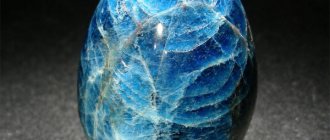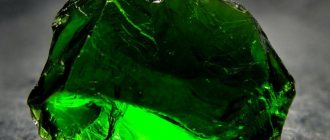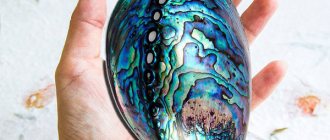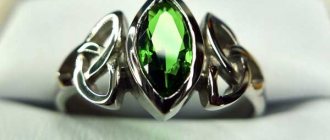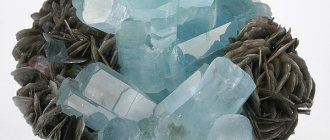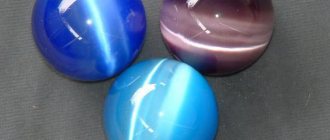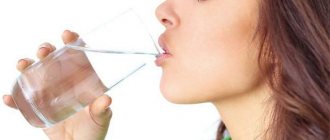| Category | Phosphates (minerals) |
| Title in English | Apatite |
| Formula | Ca5[PO4]3 |
| Group | Mineral group |
| Color | White, Green, Blue-green, Light Blue, Purple, Red |
| Stroke color | White to yellowish gray |
| Shine | Glassy to greasy |
| Transparency | Transparent, Translucent to Opaque |
| singonia | Hexagonal |
| Hardness | 5 |
| Cleavage | Imperfect |
| Density, g/cm³ | 3,2 — 3,4 |
| Kink | Conchoidal |
| origin of name | Apatite is a derived name from the Greek word ἀπατάω, which translates as “deception.” Such an interesting name was given due to the fact that the semi-precious stone can easily be confused with amethyst, tourmaline, topaz, beryl or diopside. |
| Morphology | The most common form of apatite occurs as prismatic, pre-acicular crystals. However, tabular forms are also noted. |
The geological concept of “blende” is associated with rocks that imitate various nuggets. One of these “ardent deceivers” is apatite, as even the name of this mineral indicates. It contains calcium phosphate and pure calcium, which together form beautiful and regular geometric crystals of large sizes, similar to precious gems. Apatite aggregates can weigh hundreds of kilograms! But not all stones are suitable for jewelry. Small transparent crystals are considered the highest quality. And only a few of them are pure enough and suitable for cutting and making jewelry.
Apatite deposits
Large deposits of apatite are rare.
The largest known one is located on the Kola Peninsula (Russia), where there are deposits of apatite ore that contain fluorapatite and nepheline (apatite nepheline ores). Large apatite crystals (moroxites) are mined in Transbaikalia. — Advertising —
In addition, apatite is mined in countries such as Brazil, Mexico, USA, Chile, South Africa, Finland, Spain, and Norway.
Minerals of the Kola Peninsula. Apatite
As you know, the Kola Peninsula is extremely rich in a variety of minerals and minerals. About 500 minerals have been found on the territory of the Khibiny massif, dozens of which are of practical value, 110 are not found anywhere else. Such a concentration of a huge amount of minerals in a limited area has no analogues anywhere in the world. And we have already met representatives of the Kola ores - tinguaite and natrolite. Today I want to introduce you to the mineral that gave its name to the city-scientific capital of the Arctic.
Stone-sea, stone-water.
Apatite (from ancient Greek “I deceive”) is a mineral of the phosphate class, usually pale greenish, blue, yellow-green or pink in color with a glassy sheen. The name of the mineral is due to the fact that it occurs in nature in different forms, so it was often confused with other minerals (beryl, diopside, tourmaline).
Apatite is one of the most common accessory minerals. In igneous rocks it can be one of the first to begin to crystallize, and continue until crystallization is complete, often already at the intercumulus stage. Druses of crystals are often found in miaroles in granite pegmatites, and in sedimentary rocks - in the form of rounded grains.
A characteristic mineral of carbonatites and lamprophyres. In these rocks it can be a xenocrystal, and come from both the mantle and crustal rocks, or crystallize directly from the melt.
Apatite is one of the most common biominerals. Its microcrystals are found in the teeth and bones of vertebrates and humans. It is found in all forms of life - bacteria, invertebrates and plants.
Apatite deposits are numerous. The largest industrial deposit is in Russia on the Kola Peninsula in rocks of the alkaline complex (Khibiny massif). Also the Kovdor field, Sev. Karelia, Slyudyanka (Baikal region), Yakutia, East. Siberia. Kazakhstan.
Apatite from Slyudyanka
The term “apatite” was introduced into use in 1788 by A. Werner. Apatite, a calcium phosphate, usually occurs as solid granular masses. Less commonly, individual prismatic crystals are found embedded in the rock. Opaque crystals can reach enormous sizes. For example, apatite prisms weighing more than 200 kilograms and about 2 meters long were discovered in Canada.
Jewelry apatites are found in deposits of various countries. Blue apatites are known in Burma, Brazil, Sri Lanka, Finland; blue-green - in Norway; green - in India, Canada, Mozambique, Burma, Madagascar; yellow - in Mexico, Canada, Brazil; brown - in Canada; purple - in Germany, Czechoslovakia, USA (Maine, California); colorless - Burma, Italy, Germany; with a cat's eye effect - in Sri Lanka and Burma. In Russia, jewelry apatites were found on the Kola Peninsula and in Transbaikalia - blue, in Eastern Transbaikalia and in the Pamirs - pink, in Aldan - green.
Transparent, beautifully colored apatites are used as a jewelry stone, which requires careful handling due to its rather low hardness - 5. But such jewelry stones are very rare. Jewelry apatites are quite small in size - usually up to 5 carats, occasionally up to 20 carats. Large golden-green stones weighing 147 carats were found in Kenya, and flawless stones weighing 100 carats were processed in Canada.
The color of apatite is associated with numerous impurity elements that make up the mineral. During processing, apatite is given a facet cut; less transparent stones are cabochonized. Other types of stone, due to the high phosphorus content in their composition, are used in various industries.
Esotericists and lithotherapists believe that blue apatites are able to cool raging emotions and cause the owner to have a peaceful and slightly drowsy state. It is no coincidence that apatite is called the stone of peace. Green apatite promotes a good mood and the development of an optimistic point of view.
It is believed that yellow apatite can have a beneficial effect on the entire body. Together with rock crystal, blue or colorless apatite crystals can be used to harmonize physical condition; in this way they are similar to rock crystal. Apatite is a neutral stone and is not capable of harming its owner.
This concludes our story about apatite, but there is still a lot of interesting things ahead of us! Thanks for your attention, stay on the line. 
History of apatite
The first scientific description of apatites was made at the end of the 18th century by the scientist A.G. Werner, who proposed a name for the stone. The word “apatite” is of ancient Greek origin and is translated as “I deceive.” It indicates that natural apatite is extremely diverse and can superficially resemble other stones, such as beryl, diopside and tourmaline. A diagnostic feature of apatite is the prismatic shape of its crystals and relatively low hardness.
Origin story
The history of the discovery of the mineral dates back to the end of the 18th century. Mineralogy specialist A. Werner came across the find and mistook it for another gem - beryl. It is believed that the origin of the name of the stone is connected with this fact. Translated from ancient Greek, “apatite” means “deception.”
The history of the origin of the stone in Russia is connected with the name of the Russian expert in mineralogy A.E. Fersman. In 1920, during the exploration of Khibiny, a deposit of green apatite was discovered. Only several decades later, a city of the same name was formed on this site.
Physico-chemical characteristics of apatite
In terms of their chemical composition, apatites belong to mixed calcium phosphates.
As additional elements, apatite often contains fluorine, chlorine, manganese, iron, strontium, aluminum, thorium, and rare earth elements. — Advertising —
The shape of the mineral crystals is varied: from prismatic to needle-shaped, less often short-columnar or tabular. Apatites are characterized by the presence of granular sugar-like aggregates, dense masses, radial and columnar aggregates. The fine-fiber structure is much less common.
Pure apatite crystals are colorless, completely transparent or translucent. Their color depends on the composition of impurities, for example, iron gives the mineral a smoky or yellowish tone, blue and green apatites contain manganese and lead.
The gem is characterized by the manifestation of luminescence, due to which it changes its color from different viewing angles. Blue and yellow examples are often decorated with a cat's eye effect.
The hardness of apatite on the Mohs scale is 5, which is quite low for jewelry processing and requires careful handling of the stone.
PHYSICAL PROPERTIES
| Mineral color | white, green, yellow, red, blue |
| Stroke color | white |
| Transparency | transparent to translucent |
| Shine | glassy to greasy |
| Cleavage | imperfect by (0001) and (1011) |
| Hardness (Mohs scale) | 5 |
| Kink | uneven, conchoidal |
| Strength | fragile |
| Density (measured) | 3.16 - 3.22 g/cm3 |
| Radioactivity (GRapi) | 0 |
Magical properties of apatite
All owners of jewelry and talismans with apatite are guaranteed to prevent serious upheavals in life.
This gem causes prophetic dreams to appear; it endows its owner with insight and a strong intuitive awareness of dangerous situations. Interestingly, if the stone is worn on the body, it begins to behave very actively. For example, when danger approaches, the skin that comes into contact with the stone begins to become irritated, itchy and red. And if at the same time there is a desire to get rid of the decoration, it means that the danger has reached its maximum. Still, it’s not worth parting with apatite. It is believed that when a stone is separated from its owner, it loses all its properties and becomes a dull and colorless piece of rock.
But apatite cannot damage, so it has never been used in black magic rituals.
How apatite is mined
Shortly before the New Year, I had the opportunity to visit the Russian Arctic.
This is what it looks like where there are practically no people.
And so, where there is...
Do you still think that the city of Apatity was named after the useful mineral apatite, which is mined here? I'm afraid this is not entirely true. Apathy is the main city-forming word of these places. And don’t let the locals offend me, who, according to our guide, are becoming fewer and fewer here. A rare apathetic and depressive place. Moreover, exactly on the verge of the polar night. The sun comes here, but not often. What about the mineral apatite? Yes, he is. Yes, they do. You can visit an apatite mine and see how this happens.
So, the local enterprise Phosagro. Apatite mine. God knows what kind of horizon there are - there are a lot of them, and the number goes into hundreds. The mountain is pitted with mines like a piece of sanctioned Swiss cheese. The total length of the workings exceeds 700 km! We were offered to go down into one of them. More precisely, to rise. The entrance is located quite high on the mountainside, and the adit runs horizontally.
But in order to get “up the mountain,” as they say here, you must first get special clothing, a helmet, a flashlight and a self-rescuer - an insulating gas mask, mandatory for everyone who goes underground.
All equipment is issued in a special room - a lamp room. But to get there, you need to pass your personal magnetic pass through the turnstile and... breathe into a stationary breathalyzer. If he shows anything, the turnstile will not open and will not let you into work. And absenteeism will be recorded on the report!
Let's go to the mine! Specifically, nothing has been mined here for a long time - the seam has been depleted and is only suitable for excursions and practical training at the school of a young fighter... Sorry, not a fighter, but a miner, a novice miner. They start teaching us literally from the very threshold: you can’t walk on rails! It is strictly forbidden to pass through the wide ventilation gates - they are only for trolleys and must be closed most of the time. People pass nearby, through a narrow gate with heavy spring-loaded doors.
We walk for a long time along the flimsy wooden flooring, in almost complete darkness, broken only by the light of plaintive flashlights. First stop. This huge cylinder is a turning device. Carts of ore roll into it and it turns, emptying all their contents into a huge bunker located below.
The bunker is so huge that in the light of flashlights its bottom is practically invisible. They say that it is about 40 meters away!
Side branch. It's dark and they say it's unsafe. Tourists are not allowed there.
Is this the main trunk, or whatever they call it correctly?
A miner's main tool is a jackhammer. They say that almost no one uses these today. I'm afraid the key word here is practically.
The jackhammer is supplied with compressed air to power it and water, which is sprayed to hammer down the dust. Otherwise, there would be absolutely nothing to breathe at the face. The guide shows us how it's done and even offers to try it. Very hard!
Educational and training face. Here they teach young people and show visitors how ore is mined. A grid of holes is drilled into the apatite-bearing formation (they can be seen in the photo). Then they hammer explosives into them and... Bang! You can rake out the debris and load it into trolleys. Then drill again. Thus, they go deeper into the mountain about a meter per day.
There’s probably no need to talk about the fact that the mine is damp, cold, dark and dirty. In order to fully convey the feeling of all this horror, many pages of printed text will be required. Or a short half-hour excursion will suffice. Take your child to see it, tell them that a young miner receives 35,000 rubles a month, taking into account all northern allowances and coefficients, and your child will enjoy good grades in his diary for a long time. And when the effect weakens, the excursion can be repeated. The main thing is to make sure that he does not bring home souvenirs from the mine. “Take those greenish stones as a souvenir,” they told us: “This is apatite!” It doesn't sound much. But it’s better not to pick red ones - they are, of course, more beautiful, craftsmen make souvenirs for tourists from them, but the radioactive background can sometimes be off scale!”
Mechanization! This is a decommissioned mining machine. He does everything the same as miners do manually - drills holes to plant explosives.
And this electric car shovels and transports ore. Also already outdated. They say that they didn’t like people like that in the mine. Something often shorted inside them and they suddenly began to move, crushing all those who did not have time to jump away. Nightmare!
We were not taken into the working workings, limiting ourselves to only a tour of the “training base”. Here she is. The looters did not get here, so everything valuable, with the possible exception of copper wires, remained in place.
Looters go to abandoned mines as if they were going to work, collecting on the ground and underground everything that is still valuable. And the most valuable thing in the mine is the wires and rails on which the trolleys run. They are removed first. Then there are the remains of electrical equipment, pipes, etc. A whole business has been established! Some rent, some transport, some buy and resell. And over time, the plundered mine turns into this ghost town, rising among the snow-covered forest.
These are the positive places we visited. And on my own behalf, without the help of a local guide, I’ll add: here, very close to the city of Kirovsk (just a couple of tens of kilometers from Apatity), underground nuclear tests were carried out during the Soviet years. If you believe official sources, the last explosion occurred in 1982 in the depths of Mount Kuelporr. They claim that no negative effects are being felt today. It’s possible, but I’m afraid that no one has checked this for a long time...
If you have a production or service that you would like to tell our readers about, please write to ( [email protected]
) and we will make the best report, which will be seen by thousands of readers of the site.
How it was done.
Individual photos from my reports can be viewed on Instagram Instagram
. Click on the links, subscribe and comment, if you have questions about the matter, I always answer.
My most interesting videos are also published on YouTube, support it by subscribing by clicking on this link - How it’s done
or according to this picture. Thanks to everyone who signed up!
Healing properties of apatite
For the healing properties of apatite to manifest, it must be combined with other healing minerals.
For example, crystals of yellow and brown shades in combination with other similar minerals stimulate the heart, and if blue apatites are combined with aquamarines, they will help a lecturer or singer. The harmonization of the human condition is facilitated by the combination of intensely blue apatites with jewelry made of rock crystal and diamonds.
With the help of green apatites, depression and depressed states are treated. Blue-green crystals have a calming and peaceful effect.
PROPERTIES
The color of jewelry apatite is varied: yellow-green (asparagus stone), blue, blue-green (moroxite), blue, bluish-green, violet, yellow, green, brown, colorless. The color of apatite is associated with numerous impurity elements that make up the mineral. In blue manganapatites, the color is determined by pentavalent manganese, which forms tetrahedral complexes. The pink color of apatite, which disappears when heated to a temperature of 600°C and is restored upon irradiation, is associated with ions.
Cleavage is not obvious in the basal direction; the line is light, but with different shades according to the color of individual varieties (for example, those containing carbonaceous substances have a black line). When heated, it becomes phosphorescent, and before the blowpipe it is difficult to melt only at the edges.
Applications of apatite
Non-gem quality apatite is a raw material in the production of phosphate fertilizers, phosphorus compounds and phosphate acid.
The mineral is used in ferrous and non-ferrous metallurgy, for the production of ceramics and glass. Jewelers use apatite quite rarely, which is due to its low hardness and fragility.
Typically, gem-quality apatites barely reach 5 carats, and extremely rarely – 20 carats. As a rule, such samples are an object of collector's interest, especially if they are well cut, translucent and transparent.
Optical and mechanical parameters of the stone
We have already said that apatites come in different colors, but in addition to the mentioned shades, rare purple, colorless, blue and “cat’s eye” are also known. If you heat a purple crystal, it will lose its color.
In thin sections (thin sections of rock) it is weakly or not colored at all. Light refraction is high, especially for chlorapatite.
Mohs hardness is average - 5. Glass does not scratch. Cleavage is weakly expressed. The streak is white, the crystal structure is granular, the prismatic shape is hexagonal. The luster of the mineral is glassy and resinous. Crystal can be transparent or opaque.
In general, the stone is brittle and has uneven hardness. The fracture is uneven and conchoidal. Density 3.2 g/cm3.
Fluorescence of crystals in X-ray, cathode and ultraviolet rays is often observed. Some samples thermoluminesce.
Does not induce an electric charge on the surface (is not a piezoelectric).
As for diagnostic features, the mineral is distinguished by color, hardness, and crystal shape.
How to distinguish real apatite from a fake
Apatite itself is not counterfeited, but the gem itself, even the name of which is translated as “deception,” is quite often confused with tourmalines, topazes, beryls, amethysts, diopsides and aquamarines. The main difference between apatite and precious and semi-precious stones is its low hardness.
Natural properties
It has the appearance of a prism, the fractures are always uneven, even glass can leave a scratch. There is a compacted texture around the chips. In its pure form it is found in the form of crystals.
Beryl is the closest mineral in appearance, with which it is easily confused. But there is an important difference between them: apatite is noticeably inferior to beryl in hardness.
Another variety is the small needle-shaped form. In some cases it occurs in the form of a voluminous structureless mass. The characteristic feature by which it differs from others is the vertical strokes across the entire surface.
It is present in the rock in a small dose, the apatite content is usually less than 1%. Due to the fact that crystal formation occurs in magma, there is no limit to size. The largest specimen was discovered in Canada and weighed 5 tons. It is no coincidence that Canada considers this mineral one of the symbols of the country.
The stone does not like exposure to sunlight. A few sunny days are enough for it to begin to change its natural color. Has a natural tendency to burn out.
Prices for apatite products
Considering the varied properties and quality of apatites, their prices also vary widely. For example, transparent, clean samples with a beautiful cut are valued at $2-3 per carat. Heterogeneous stones with defects are valued much lower. Beads are often made from them. The cheapest specimens of apatite are those that are ground into cabochons. Such stones are opaque and layered. Pendants and other small jewelry are made from fractured apatites, the cost of which is very low.
Who are we?
Actually, if you carefully read the initial chapters of the Old Testament, you can be amazed to realize that the Creator created the first man on Earth not from flesh and blood, but from a certain rock called in the scripture clay or dust of the earth.
This is confirmed by the ancient prophets, who asserted that man was created from the dust of the earth and will return to dust. Here we are also not talking about biological substances, but rather about rocks.
In 1992, scientists discovered that microscopic nano-entities of mineral origin (among them apatite) exist inside each of us. They are an integral part of the functioning mechanism of the human body.
Strange cosmic apatite nanobacteria provide a unique perspective on ancient mythology.
Apatite formula
Ca5[PO4]3(F, Cl, OH)
Synonyms: Basic synonyms . From Spain: Chrysolite ordinaire de Lisle (1772; 2, 271, 1783) = Spargelgriine Steinkrystalle aus Spanien nahern Apatit Werner (Bergm. J., 74, 1790) = Spargelstein Werner, Asparagus Stone. Fr Pierre d'Asperge. Asparagolithe Abildgaard (Ann. chim., 32, 195, 1800); Chaux phosphatee Vauquelin (Ann. chim., 26, 123, 1798); Phosphate of Lime. From Saxony: Aquamarin Briinnich [in his edition by Cronstedt (Cronedt, Copenhagen, 1770)]. Amefhiste basaltine Sage (1, 231, 1777); de Lisle (2, 254, 1783) = Apatit Werner (Gerhard's Grundr., 281, 1786; Bergm. J., 576, 1788 and 378, 1789); Phosphorsaurer-Kaik Klaproth (Bergm. J., 294, 1788); Sach-sl*Cher Beryll, Augustit Trommsdorf (J. de pharm., 8, 153, 1800). Moroxit [Hopwegia] Abildgaard (Moll's Berg.-Htitten., Jo., 2, 432, 1798).
Russian synonyms : azure-apatite. NordenskiOld (Bull. soc. nat. Moscow, 30, 217, 224, 1857). Apatit [all Varieties except moroxite] Karsten (36, 1800); Apatite [including moroxite] (2, 1801). Massive: La Pierre Phosphorique [from Spain] Davila - D Phosphate calcaire Proust (J. phys., 32, 241, 1788); Pelletier (Ann. chim., 7, '90) = Phosphorite Kirwan (1, 129, 1794), Karsten (52, 1808); Osteolith Bromeis (Ann. Chem. Pharm., 79, 1851) = Bone-phosphate. Talkapatit Hermann (J. pr. Chem., 31, 101, 1844). Manganapatit Siewert (Zs, Nat. Halle, 10, 339, 1874). Cupro-apatit (?) Adam (45, 1869). Epiphosphorite Breithaupt (B. H. Ztg., 25, 194, 1866). Pyroguanite, Giaubapatite (part of) Shepard (Am. J. Sc., 22, 96, 1856). Sombrerite Phipson (J. Chem. Soc. Loticin 15, 277, 1862). Estramadurite Roscoe and Schorlemmer (Treat, on Chem., 1 4 1877). Kietyoite NordenskiOld (Min. Finland, 154, 1863). Odontolite (part of Floridite Cox (Proc. Am. Assoc., 39, 260, 1891). Ciplyte (?) Ortlier (Bull' min., 13, 160, 1890).
